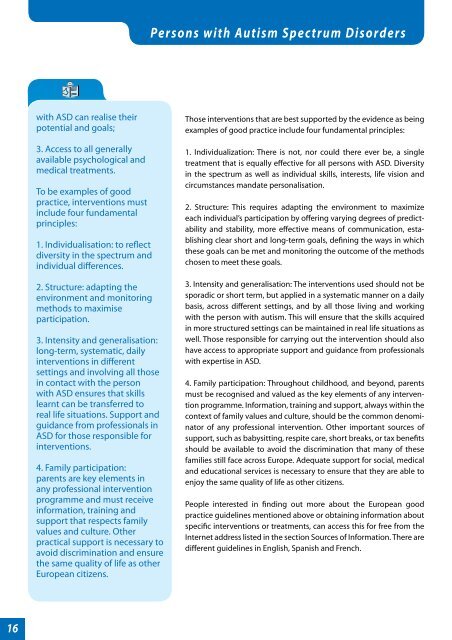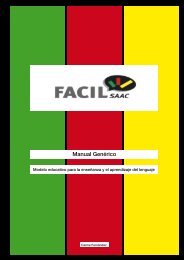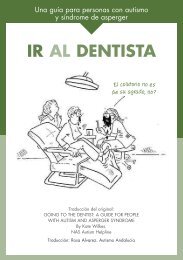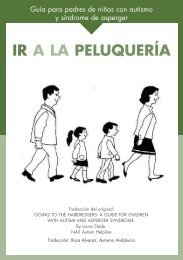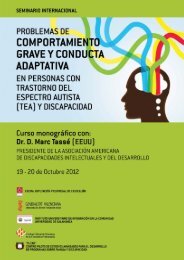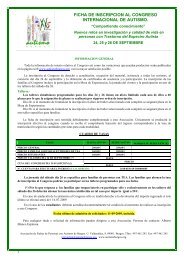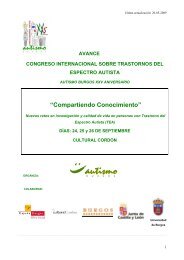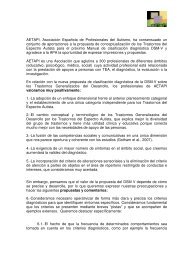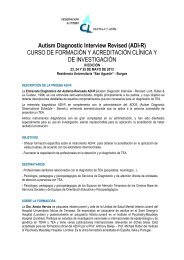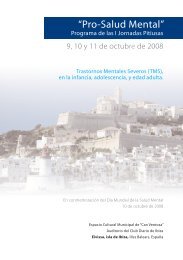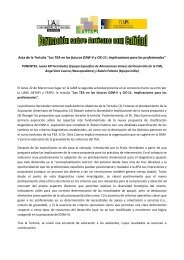persons with autism spectrum disorders - Aetapi
persons with autism spectrum disorders - Aetapi
persons with autism spectrum disorders - Aetapi
You also want an ePaper? Increase the reach of your titles
YUMPU automatically turns print PDFs into web optimized ePapers that Google loves.
16<br />
<strong>with</strong> ASD can realise their<br />
potential and goals;<br />
3. Access to all generally<br />
available psychological and<br />
medical treatments.<br />
To be examples of good<br />
practice, interventions must<br />
include four fundamental<br />
principles:<br />
1. Individualisation: to reflect<br />
diversity in the <strong>spectrum</strong> and<br />
individual differences.<br />
2. Structure: adapting the<br />
environment and monitoring<br />
methods to maximise<br />
participation.<br />
3. Intensity and generalisation:<br />
long-term, systematic, daily<br />
interventions in different<br />
settings and involving all those<br />
in contact <strong>with</strong> the person<br />
<strong>with</strong> ASD ensures that skills<br />
learnt can be transferred to<br />
real life situations. Support and<br />
guidance from professionals in<br />
ASD for those responsible for<br />
interventions.<br />
4. Family participation:<br />
parents are key elements in<br />
any professional intervention<br />
programme and must receive<br />
information, training and<br />
support that respects family<br />
values and culture. Other<br />
practical support is necessary to<br />
avoid discrimination and ensure<br />
the same quality of life as other<br />
European citizens.<br />
Persons <strong>with</strong> Autism Spectrum Disorders<br />
Those interventions that are best supported by the evidence as being<br />
examples of good practice include four fundamental principles:<br />
1. Individualization: There is not, nor could there ever be, a single<br />
treatment that is equally effective for all <strong>persons</strong> <strong>with</strong> ASD. Diversity<br />
in the <strong>spectrum</strong> as well as individual skills, interests, life vision and<br />
circumstances mandate personalisation.<br />
2. Structure: This requires adapting the environment to maximize<br />
each individual’s participation by offering varying degrees of predictability<br />
and stability, more effective means of communication, establishing<br />
clear short and long-term goals, defining the ways in which<br />
these goals can be met and monitoring the outcome of the methods<br />
chosen to meet these goals.<br />
3. Intensity and generalisation: The interventions used should not be<br />
sporadic or short term, but applied in a systematic manner on a daily<br />
basis, across different settings, and by all those living and working<br />
<strong>with</strong> the person <strong>with</strong> <strong>autism</strong>. This will ensure that the skills acquired<br />
in more structured settings can be maintained in real life situations as<br />
well. Those responsible for carrying out the intervention should also<br />
have access to appropriate support and guidance from professionals<br />
<strong>with</strong> expertise in ASD.<br />
4. Family participation: Throughout childhood, and beyond, parents<br />
must be recognised and valued as the key elements of any intervention<br />
programme. Information, training and support, always <strong>with</strong>in the<br />
context of family values and culture, should be the common denominator<br />
of any professional intervention. Other important sources of<br />
support, such as babysitting, respite care, short breaks, or tax benefits<br />
should be available to avoid the discrimination that many of these<br />
families still face across Europe. Adequate support for social, medical<br />
and educational services is necessary to ensure that they are able to<br />
enjoy the same quality of life as other citizens.<br />
People interested in finding out more about the European good<br />
practice guidelines mentioned above or obtaining information about<br />
specific interventions or treatments, can access this for free from the<br />
Internet address listed in the section Sources of Information. There are<br />
different guidelines in English, Spanish and French.


